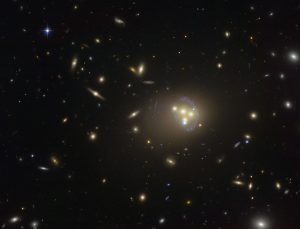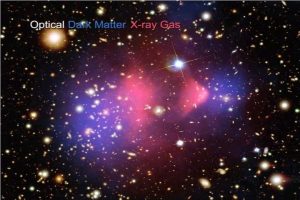
Are astronomers convinced that dark matter is the answer?
Is it likely that there is a simpler alternative theory to help explain why general relativity fails at galactic scales?
I will answer the second question first: no. All the simpler alternatives have been tested and they fail to explain all the observations. It is very unlikely a simple alternative will explain the issue by now.
The first question requires a more nuanced response: statistically, it is fair to say that a majority of astronomers accept dark matter as the answer, but there is still a sizable number of colleagues working on alternative theories. Also, saying that dark matter is THE answer still leaves the huge question of “what is dark matter?” unanswered.
I personally favor the dark matter interpretation for two big reasons and one picky point.
The first reason is that at this point dark matter is necessary to explain observed phenomena at a large range of scales, from the Solar System’s to cosmological scales and many things in between. No alternative theory has been able to cover all of these scales. Some of them do very well at galactic and smaller scales, but they break at galaxy cluster scales. Not a single one has been able to perform cosmological simulations to check if the resulting universe after the Big Bang looks even remotely like our Universe, and they cannot fit observations from the Cosmic Microwave Background. So, on one hand, we have dark matter, with all its unknowns, which explains a very large array of observations and has only a couple of unresolved issues; and on the other hand we have a large number of different modifications of gravity that sometimes explain some observations, and never manage to do cosmology.
The second reason is galaxy clusters, in particular the Bullet Cluster.

This is actually two galaxy clusters that smashed into each other. Given the separation between galaxies, the clusters can cross each other without any of their galaxies being perturbed at all. The hot intergalactic gas, observed with X-ray telescopes definitely gets perturbed when the clusters encounter, but it turns out that this can only happen if there is a matter in between the galaxies, it cannot happen if there is nothing and it cannot happen with modified gravity either. Dark matter is the only thing that can explain this observation. A detailed explanation of this observation can be found in this blog post.
The picky point is that alternative theories to dark matter are very, very ugly mathematically, which doesn’t mean they are wrong, but it means they are extremely difficult to work with and that’s why nobody has been able to do meaningful simulations with them. Also, this means that there is not one competing alternative to dark matter, but instead there are dozens (if not hundreds) of modifications to the canonical gravity we use in Physics. A very annoying caveat is that some of these theories break a fundamental principle in Physics called “Lorentz Invariance”. Again, breaking existing physics does not prove that something is wrong, but it surely demands that the proof for it is irrefutable, and in this case, it is not.
Details about the evidence for dark matter can be found in this blog post at http://www.preposterousuniverse.com/blog/2011/02/26/dark-matter-just-fine-thanks/ or in (long) video form at https://www.youtube.com/watch?v=iu7LDGhSi1A.
Dr. Eva Noyola
UT Austin